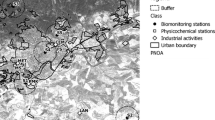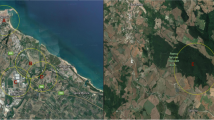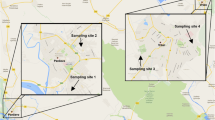Abstract
Honeybees have been used in Europe as environmental bioindicators for heavy metals and polycyclic aromatic hydrocarbons (PAHs). However, their potential has been little explored in North America, especially between environments which have similar pollution levels. Many urban residents and stakeholders are concerned with air quality, mainly in regard to gradients of exposure to industrial pollution between deprived and privileged subpopulation. Thus, the aim of this study was to evaluate the use of honeybees as bioindicators to assess exposure to heavy metals and PAHs in Québec City, Canada, in different socioeconomic districts of Quebec City (deprivation index). Honeybees were sampled over a 5-month period (May to September) at six locations distributed in two urban areas that are distinct geomorphologically and socioeconomically (lower town socio-economically deprived and upper town socioeconomically privileged) and two control rural locations. Six PAHs were analyzed by ultra-performance liquid chromatography (UPLC), while four heavy metals were analyzed by inductively coupled plasma mass spectrometry. Arsenic was the only measured pollutant that showed a significant gradient of exposure between rural and urban environments, but also between the two urban areas. Furthermore, we were able to detect significant differences at certain sampling times for heavy metals and PAHs. Overall, the results show that honeybees are sensitive enough to detect differences between the differential urban environments of a city presumed to have similar pollution levels and therefore could be used when potential socio-environmental inequalities are present.





Similar content being viewed by others
Availability of data and material
Data available on request from the authors.
Code availability
Code available on request from the authors.
References
Abdel-Shafy, H. I., & Mansour, M. S. (2016). A review on polycyclic aromatic hydrocarbons: Source, environmental impact, effect on human health and remediation. Egyptian Journal of Petroleum, 25(1), 107–123.
Amorena, M., Visciano, P., Giacomelli, A., Marinelli, E., Sabatini, A. G., Medrzycki, P., Oddo, L. P., De Pace, F. M., Belligoli, P., & Di Serafino, G. (2009). Monitoring of levels of polycyclic aromatic hydrocarbons in bees caught from beekeeping: Remark 1. Veterinary Research Communications, 33(1), 165–167.
Badiou-Bénéteau, A., Benneveau, A., Géret, F., Delatte, H., Becker, N., Brunet, J. L., Reynaud, B., & Belzunces, L. P. (2013). Honeybee biomarkers as promising tools to monitor environmental quality. Environment International, 60, 31–41.
Baldantoni, D., De Nicola, F., & Alfani, A. (2014). Air biomonitoring of heavy metals and polycyclic aromatic hydrocarbons near a cement plant. Atmospheric Pollution Research, 5(2), 262–269. https://doi.org/10.5094/APR.2014.032
Bencze, L., & Pouliot, C. (2017). Battle of the bands: Toxic dust, active citizenship and science education. Science and technology education promoting wellbeing for individuals, societies and environments (pp. 381–404). Springer.
Calabrese, E. J., Stanek, E., James, R. C., & Roberts, S. M. (1997). Soil ingestion: A concern for acute toxicity in children. Environmental Health Perspectives, 105(12), 1354–1358.
Ciemniak, A., Witczak, A., & Mocek, K. (2013). Assessment of honey contamination with polycyclic aromatic hydrocarbons. Journal of Environmental Science and Health, Part B, 48(11), 993–998.
Conti, M. E., & Botrè, F. (2001). Honeybees and their products as potential bioindicators of heavy metals contamination. Environmental Monitoring and Assessment, 69(3), 267–282.
Crouse, D. L., Ross, N. A., & Goldberg, M. S. (2009). Double burden of deprivation and high concentrations of ambient air pollution at the neighbourhood scale in Montreal. Canada. Social Science & Medicine, 69(6), 971–981.
Cui, L., Wu, Z., Han, P., Taira, Y., Wang, H., Meng, Q., Feng, Z., Zhai, S., Yu, J., Zhu, W., Kong, Y., Wang, H., Zhang, H., Bai, B., Lou, Y., & Ma, Y. (2019). Chemical content and source apportionment of 36 heavy metal analysis and health risk assessment in aerosol of Beijing. Environmental Science and Pollution Research. https://doi.org/10.1007/s11356-019-06427-w
Deng, W. J., Louie, P. K. K., Liu, W. K., Bi, X. H., Fu, J. M., & Wong, M. H. (2006). Atmospheric levels and cytotoxicity of PAHs and heavy metals in TSP and PM2. 5 at an electronic waste recycling site in southeast China. Atmospheric Environment, 40(36), 6945–6955.
DSP (2018). Projet « Mon environnement, ma santé » : volet de la qualité de l’air extérieur. Cadrage du projet. Retrieved December 13, 2020, from https://www.ciusss-capitalenationale.gouv.qc.ca/sites/d8/files/docs/ProfSante/SPU/dsp_mems_cadrage_v.2019-02-25_vf.pdf.
Fang, G.-C., Chang, C.-N., Chu, C.-C., Wu, Y.-S., Fu, P. P.-C., Yang, I.-L., & Chen, M.-H. (2003). Characterization of particulate, metallic elements of TSP, PM2. 5 and PM2. 5–10 aerosols at a farm sampling site in Taiwan, Taichung. Science of the Total Environment, 308(1–3), 157–166.
Fang, G.-C., Chang, C.-Y., Huang, Y.-L., & Huang, J.-H. (2012). Atmospheric arsenic (As) concentrations in different countries during 2000–2011. Environmental Forensics, 13(1), 27–31.
GC (1994a). Cadmium and its Compounds. Priority Substances List Assessment Report. Government of Canada. Retrieved December 16, 2020, https://www.canada.ca/content/dam/hc-sc/migration/hc-sc/ewh-semt/alt_formats/hecs-sesc/pdf/pubs/contaminants/psl1-lsp1/cadmium_comp/cadmium_comp-eng.pdf.
GC (1994b). Nickel and its Compounds. Priority Substances List Assessment Report. Government of Canada. Retrieved December 16, 2020, https://www.canada.ca/content/dam/hc-sc/migration/hc-sc/ewh-semt/alt_formats/hecs-sesc/pdf/pubs/contaminants/psl1-lsp1/compounds_nickel_composes/nickel-eng.pdf.
GC (2013). Final Human Health State of the Science Report on Lead. Ressource document. Minster of Health. Retrieved December 16, 2020, https://www.canada.ca/content/dam/hc-sc/migration/hc-sc/ewh-semt/alt_formats/pdf/pubs/contaminants/dhhssrl-rpecscepsh/dhhssrl-rpecscepsh-eng.pdf.
GC (2013b). Rapport final sur l’état des connaissances scientifiques concernant les effets du plomb sur la santé humaine. (ISBN 978–1–100–998–11–4). Retrieved December 16, 2020, from https://www.canada.ca/content/dam/hc-sc/migration/hc-sc/ewhsemt/alt_formats/pdf/pubs/contaminants/dhhssrl-rpecscepsh/dhhssrl-rpecscepshfra.pdf.
Giglio, A., Ammendola, A., Battistella, S., Naccarato, A., Pallavicini, A., Simeon, E., Tagarelli, A., & Giulianini, P. G. (2017). Apis mellifera ligustica, Spinola 1806 as bioindicator for detecting environmental contamination: A preliminary study of heavy metal pollution in Trieste. Italy. Environmental Science and Pollution Research, 24(1), 659–665.
Guerreiro, C. B., Foltescu, V., & De Leeuw, F. (2014). Air quality status and trends in Europe. Atmospheric Environment, 98, 376–384.
Gutiérrez, M., Molero, R., Gaju, M., van der Steen, J., Porrini, C., & Ruiz, J. A. (2015). Assessment of heavy metal pollution in Córdoba (Spain) by biomonitoring foraging honeybee. Environmental Monitoring and Assessment, 187(10), 651.
Hajat, A., Hsia, C., & O’Neill, M. S. (2015). Socioeconomic disparities and air pollution exposure: A global review. Current Environmental Health Reports, 2(4), 440–450. https://doi.org/10.1007/s40572-015-0069-5
Haluza-Delay, R. (2007). Environmental Justice in Canada. Local Environment, 12(6), 557–563. https://doi.org/10.1080/13549830701657323
Herrero-Latorre, C., Barciela-García, J., García-Martín, S., & Peña-Crecente, R. M. (2017). The use of honeybees and honey as environmental bioindicators for metals and radionuclides: A review. Environmental Reviews, 25(4), 463–480.
International Agency for Research on Cancer. (2011). Arsenic, metals, fibres, and dusts: IARC monographs on the evaluation of carcinogenic risks to humans, volume 100C.
Jaishankar, M., Tseten, T., Anbalagan, N., Mathew, B. B., & Beeregowda, K. N. (2014). Toxicity, mechanism and health effects of some heavy metals. Interdisciplinary Toxicology, 7(2), 60–72.
Jia, C., & Foran, J. (2013). Air toxics concentrations, source identification, and health risks: An air pollution hot spot in southwest Memphis, TN. Atmospheric Environment, 81, 112–116.
Kalugina, O. V., Mikhailova, T. A., & Shergina, O. V. (2018). Contamination of Scots pine forests with polycyclic aromatic hydrocarbons on the territory of industrial city of Siberia. Russia. Environmental Science and Pollution Research, 25(21), 21176–21184.
Kampa, M., & Castanas, E. (2008). Human health effects of air pollution. Environmental Pollution, 151(2), 362–367. https://doi.org/10.1016/j.envpol.2007.06.012
Kargar, N., Matin, G., Matin, A. A., & Buyukisik, H. B. (2017). Biomonitoring, status and source risk assessment of polycyclic aromatic hydrocarbons (PAHs) using honeybees, pine tree leaves, and propolis. Chemosphere, 186, 140–150.
Kim, K.-H., Jahan, S. A., Kabir, E., & Brown, R. J. (2013). A review of airborne polycyclic aromatic hydrocarbons (PAHs) and their human health effects. Environment International, 60, 71–80.
Lambert, O., Veyrand, B., Durand, S., Marchand, P., Le Bizec, B., Piroux, M., Puyo, S., Thorin, C., Delbac, F., & Pouliquen, H. (2012). Polycyclic aromatic hydrocarbons: Bees, honey and pollen as sentinels for environmental chemical contaminants. Chemosphere, 86(1), 98–104. https://doi.org/10.1016/j.chemosphere.2011.09.025
Landrigan, P. J., Fuller, R., Acosta, N. J. R., Adeyi, O., Arnold, R., Basu, N., Balde, A. B., Bertollini, R., Bose-O’Reilly, S., Boufford, J. I., Breysse, P. N., Chiles, T., Mahidol, C., Coll-Seck, A. M., Cropper, M. L., Fobil, J., Fuster, V., Greenstone, M., Haines, A., & Zhong, M. (2018). The Lancet Commission on pollution and health. Lancet, 391(10119), 462–512. https://doi.org/10.1016/S0140-6736(17)32345-0
Long, G., Peng, Y., & Bradshaw, D. (2012). A review of copper–arsenic mineral removal from copper concentrates. Minerals Engineering, 36–38, 179–186. https://doi.org/10.1016/j.mineng.2012.03.032
Miao, Q., Chen, D., Buzzelli, M., & Aronson, K. J. (2015). Environmental equity research: Review with focus on outdoor air pollution research methods and analytic tools. Archives of Environmental & Occupational Health, 70(1), 47–55. https://doi.org/10.1080/19338244.2014.904266
Pampalon, R., Hamel, D., Gamache, P., & Raymond, G. (2009). A deprivation index for health planning in Canada. Chronic Diseases in Canada, 29(4), 15.
Perugini, M., Di Serafino, G., Giacomelli, A., Medrzycki, P., Sabatini, A. G., Oddo, L. P., Marinelli, E., & Amorena, M. (2009). Monitoring of polycyclic aromatic hydrocarbons in bees (Apis mellifera) and honey in urban areas and wildlife reserves. Journal of Agricultural and Food Chemistry, 57(16), 7440–7444. https://doi.org/10.1021/jf9011054
Pinheiro, J., Bates, D., DebRoy, S., Sarkar, D., R Core Team (2021). _nlme: Linear and nonlinear mixed effects models_. R package version 3.1–152. Retrieved March 1, 2021, from https://CRAN.R-project.org/package=nlme.
Porrini, C., Sabatini, A. G., Girotti, S., Ghini, S., Medrzycki, P., Grillenzoni, F., Bortolotti, L., Gattavecchia, E., & Celli, G. (2003). Honey bees and bee products as monitors of the environmental contamination. Apiacta, 38(1), 63–70.
Provatas, A. A., Yeudakimau, A. V., Stuart, J. D., & Perkins, C. R. (2013). Rapid sample preparation for determination of PAHs in wild-caught avian eggs utilizing QuEChERS extraction and Ostro 96-well plate cleanup followed by UPLC-UV analysis. Waters Publication.
Rengarajan, T., Rajendran, P., Nandakumar, N., Lokeshkumar, B., Rajendran, P., & Nishigaki, I. (2015). Exposure to polycyclic aromatic hydrocarbons with special focus on cancer. Asian Pacific Journal of Tropical Biomedicine, 5(3), 182–189.
R Core Team (2021). R: A language and environment for statistical computing. R Foundation for Statistical Computing, Vienna, Austria. Retrieved March 1, 2021, from https://www.R-project.org/
Rodriguez, J. H., Wannaz, E. D., Salazar, M. J., Pignata, M. L., Fangmeier, A., & Franzaring, J. (2012). Accumulation of polycyclic aromatic hydrocarbons and heavy metals in the tree foliage of Eucalyptus rostrata, Pinus radiata and Populus hybridus in the vicinity of a large aluminium smelter in Argentina. Atmospheric Environment, 55, 35–42.
Ruiz, J. A., Gutiérrez, M., & Porrini, C. (2013). Biomonitoring of bees as bioindicators. Bee World, 90(3), 61–63.
Sexton, K., & Linder, S. H. (2011). Cumulative risk assessment for combined health effects from chemical and nonchemical stressors. American Journal of Public Health, 101(S1), S81–S88.
Slezakova, K., Castro, D., Delerue-Matos, C., da Conceição Alvim-Ferraz, M., Morais, S., & do Carmo Pereira, M. . (2013). Impact of vehicular traffic emissions on particulate-bound PAHs: Levels and associated health risks. Atmospheric Research, 127, 141–147.
Smith, K. E., Weis, D., Amini, M., Shiel, A. E., Lai, V.W.-M., & Gordon, K. (2019). Honey as a biomonitor for a changing world. Nature Sustainability, 2(3), 223–232.
Statistics Canada. (2016). Census Profile, 2016 Census. Retrieved March 1, 2021, from https://www12.statcan.gc.ca/census-recensement/2016/dp-pd/prof/details/page.cfm?Lang=E&Geo1=CSD&Code1=2423027&Geo2=CD&Code2=2423&Data=Count&SearchText=quebec&SearchType=Begins&SearchPR=01&B1=All&TABID=1.
Tchounwou, P. B., Yedjou, C. G., Patlolla, A. K., & Sutton, D. J. (2012). Heavy metals toxicity and the environment. EXS, 101, 133–164. https://doi.org/10.1007/978-3-7643-8340-4_6.
Tran-Lam, T.-T., Hai Dao, Y., Nguyen, K. T., & L., Kim Ma, H., Nguyen Tran, H., & Truong Le, G. . (2018). Simultaneous determination of 18 polycyclic aromatic hydrocarbons in daily foods (Hanoi Metropolitan Area) by gas chromatography–tandem mass spectrometry. Foods, 7(12), 201.
Van der Steen, J. J. M., Cornelissen, B., Blacquière, T., Pijnenburg, J., & Severijnen, M. (2016). Think regionally, act locally: Metals in honeybee workers in the Netherlands (surveillance study 2008). Environmental Monitoring and Assessment, 188(8), 463.
Walsh, P. et Brière J.-F. (2018). L’incinérateur et la qualité de l’air dans l’arrondissement La Cité-Limoilou. Retrieved January 5, 2021, from http://www.environnement.gouv.qc.ca/air/ambient/incinerateur/rapport-prog-echantillonnage.pdf.
Acknowledgements
Our thanks to Dominic Larivière’s team for heavy metals analysis, Jacinthe Julien for laboratory assistance, Gaétan Daigle for statistical support and beekeepers Émile Houle, Jérémie Doyon, Alexia D. Drouin and Gabriel Gagnon-Anctil.
Funding
This research is part of a larger project focusing on air quality in Québec City and was funded by the city of Québec.
Author information
Authors and Affiliations
Contributions
EG, PG and IGS contributed to the design of the experiment and interpretation of the results. EG collected the data and performed statistical analysis. EG and CJ developed and performed lab analysis. EG drafted the manuscript. PG, CJ and IGS proofread the manuscript.
Corresponding author
Ethics declarations
Ethics approval and consent to participate
Not applicable.
Consent for publication
Not applicable.
Conflict of interest
The authors declare no competing interests.
Additional information
Publisher's Note
Springer Nature remains neutral with regard to jurisdictional claims in published maps and institutional affiliations.
Rights and permissions
About this article
Cite this article
Grenier, É., Giovenazzo, P., Julien, C. et al. Honeybees as a biomonitoring species to assess environmental airborne pollution in different socioeconomic city districts. Environ Monit Assess 193, 740 (2021). https://doi.org/10.1007/s10661-021-09485-1
Received:
Accepted:
Published:
DOI: https://doi.org/10.1007/s10661-021-09485-1




